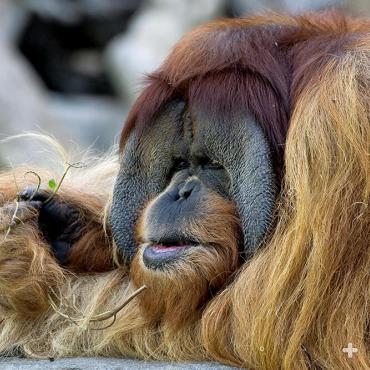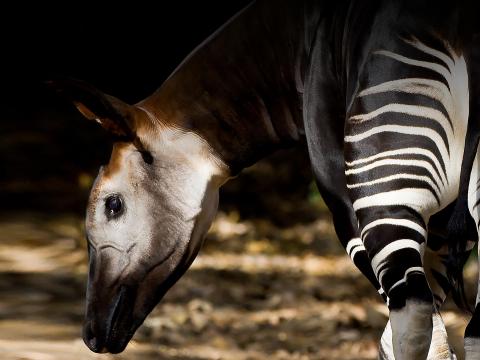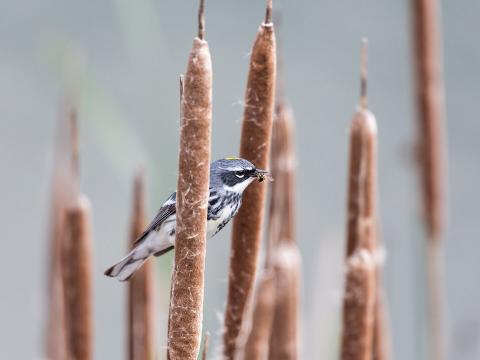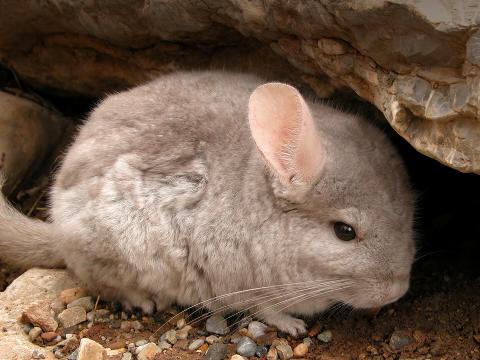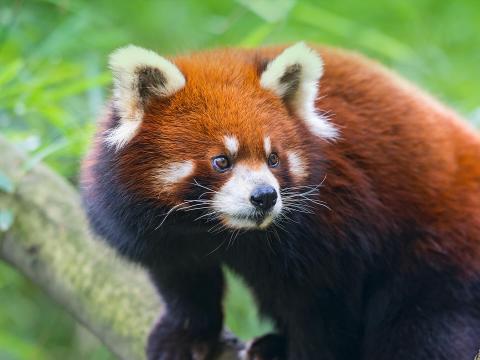Orangutan
- CLASS: Mammalia (Mammals)
- ORDER: Primates
- FAMILY: Pongidae
- GENUS: Pongo
- SPECIES: abelli (Sumatran orangutan); pygmaeus (Bornean orangutan); tapanuliensis (Tapanuli orangutan)
ABOUT
Red apes of the forest: Orangutans live in tropical and swamp forests on the Southeast Asian islands of Borneo and Sumatra. These shaggy red apes are the largest arboreal mammal and the only great ape found in Asia. The other great apes—gorillas, chimpanzees, and bonobos—are all native to Africa.
Long, flowing, reddish hair covers most of an orangutan’s gray skin. Its stocky body has a flexible pelvis, a thick neck, and bowed legs. The orangutan's arms are longer than its legs, reaching nearly to its ankles when the ape stands up. Like other apes, orangutans don't have a tail.
Orangutans spend most of their life in the trees, swinging confidently from branch to branch. Their long fingers and toes can easily grasp branches and vines. With arms longer than their body and long, strong fingers and prehensile feet, life in the trees works well for them. In fact, orangutans look a bit awkward on the ground, using their arms as we might use a pair of crutches or lifting those arms high above their head when they walk. Adult male orangutans are much larger than adult females.
There are some differences between the three orangutan species:
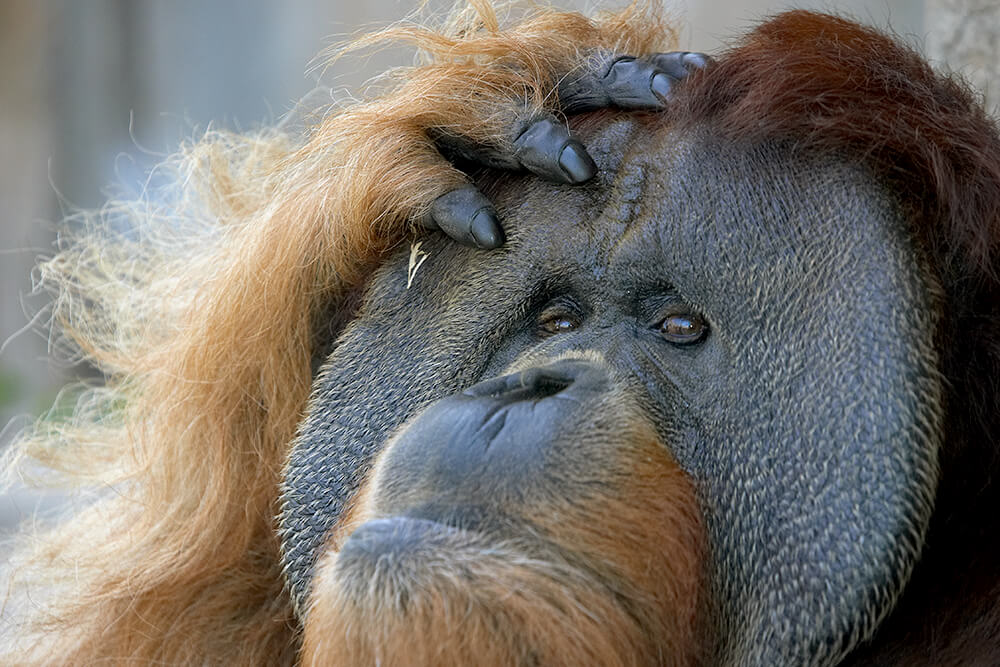
Sumatran orangutan: Lives on Sumatra. The hair is longer and lighter-colored than that of Bornean orangutans. The adult male’s cheek pads, called flanges, form rigid half circles on the sides of his face, and both males and females usually develop beards as they age.
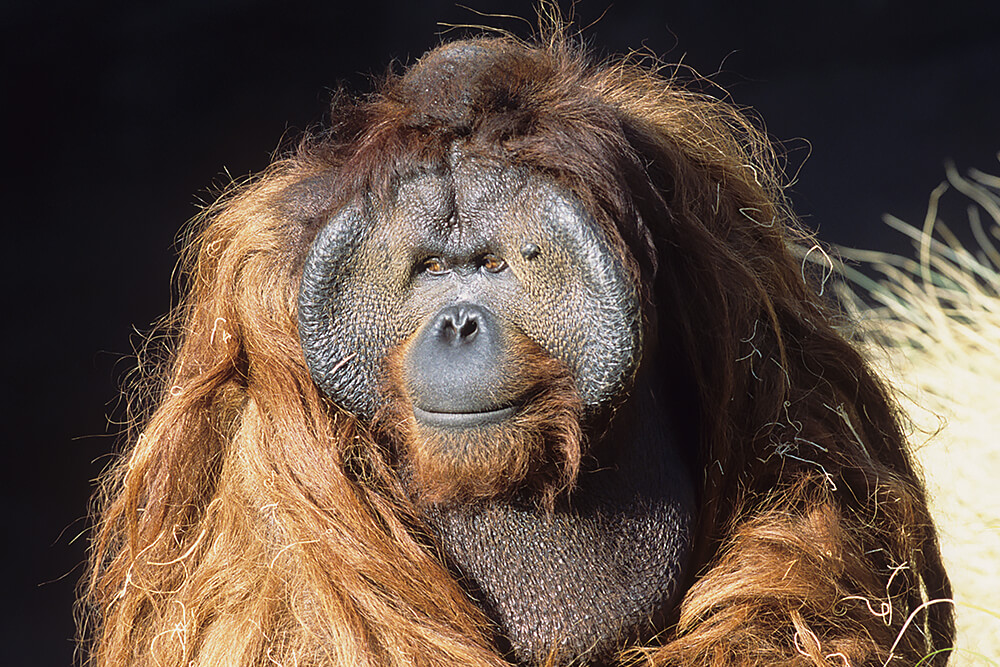
Bornean orangutan: Lives on Borneo. Adult males have much larger flanges and a large throat pouch. The hair is shinier, and the females rarely have any beard at all. Bornean orangutans are more heavy-set than Sumatran orangutans.
Tapanuli orangutan: The southernmost population of orangutans on Sumatra. This species, described in 2017, differs from both of the other two species in subtle—but consistent—ways: it has a slightly smaller skull, a shallower face, and various skull, jaw, and tooth measurements that differ. In comparison to the other species on Sumatran, Tapanuli orangutans have shorter, frizzier, cinnamon-colored hair.
Within all three species, there are two morphs of mature male orangutans, and it’s easy to tell them apart. A cheek-padded, or flanged, male has big, fleshy cheek pads on the sides of his face and a large throat sac under his chin. He’s more likely to have facial hair, and the hair on his back grows long.
Non-cheek-padded, or unflanged, males don’t have these traits. They are usually smaller than cheek-padded males. Both flanged and unflanged males are able to father offspring.
Orangutans are the loners and the daydreamers of the great apes. While the other great apes are usually found in groups socializing, foraging, or playing, orangutans tend to be more solitary and seem to have a more internal approach to everything. While other great apes might go from tree to tree searching for fruit, an orangutan just sits in the forest canopy for hours on end until the location of the hidden fruit seems to mysteriously reveal itself and the orangutan swings over for its meal.
Scientists like to explain the orangutan’s unique approach to problem solving with this example: If a chimpanzee is given an oddly shaped peg and several different holes to try to put it in, the chimpanzee immediately tries shoving the peg in various holes until it finds the correct hole. But an orangutan approaches the challenge quite differently. It may stare off into space or even scratch itself with the peg. Then, after a while, it offhandedly sticks the peg into the correct hole while looking at something else that has caught its interest!
HABITAT AND DIET
Orangutans spend most of their lives in trees and travel by swinging from branch to branch with their long arms. They usually build a new nest every night, but may occasionally reuse one. The apes also use leafy branches to shelter themselves from rain and sun, and sometimes they drape large leaves over themselves like a poncho!
Orangutans on Sumatra, especially younger ones, have to worry about tigers, as well as other predators such as clouded leopards, large pythons, and crocodiles. To stay safe, they tend to spend more time in the trees than Bornean orangutans, which don’t have those predators on their island so can safely spend more time on the ground.

Orangutans eat lots of ripe fruits—up to 100 kinds. Figs, along with fruit of the durian tree, are most common. When fruits are scarce, they eat leaves, flowers, bark, honey, termites, ants and other insects, and even bird eggs. Their mornings and afternoons are spent foraging for these food items, with nap time during the midday’s heat. Sometimes several mothers and their young encounter each other by a fruit tree within their overlapping ranges. They peacefully feed together and watch their youngsters play. Adult males, however, generally don’t care for company—especially with other males.
Although the apes get lots of water from the fruits and other vegetation they eat, they drink water, too. They lick water from tree hollows, wet plants, and even from the fur on their arms.
FAMILY LIFE
Orangutans have large home ranges, which may overlap. Each adult female usually lives in a stable home range of about 3.5 square miles (9 square kilometers). An adult male’s territory may be up to 15 square miles (39 square kilometers). A male’s range may overlap with the home ranges of several females. Males tend to be more nomadic, visiting female ranges as needed. If a male accidentally swings into a territory occupied by a more dominant male, the dominant male gives a booming roar called a “long call” to scare off the intruder.
The male orangutans’ calls also serve as an invitation to any available females within hearing distance. The females seem to be impressed by a male orangutan’s cheek pads, but the pads have another purpose. When males are fighting, they charge at each other and break branches. If that doesn’t scare one of them away, they grab and bite each other on the cheek pads or ears until one of them gives up and runs away!
All other apes and monkeys live in social groups, but orangutans are a little different. Experts used to think they were solitary, but recent studies tell us more. On Sumatra, small groups or pairs of adolescents, a few adult females, or even a small group of non-cheek-padded males may travel together for a few days at a time. Sometimes several mothers and their young feed peacefully together while their youngsters play.
On both islands, cheek-padded males don’t care for company. They compete for mates and territory, and they don’t tolerate each other. These guys remain alone unless breeding with a female or fighting with another male.
Orangutans have the slowest breeding rate of all mammals. They reproduce only every seven or eight years, the longest interval of all land mammals. Orangutan females usually have their first baby at age 12 to 15, which is late compared to other mammals. Males don’t reach maturity until they are about 15 years old.
Newborns have pink faces that change to dark brown or black as they age, and look adorable, with tufts of hair that stand straight up. For its first few weeks of life, the baby holds tight to its mother’s belly as she swings through the forest in search of fruit. When it is older and better at balancing, the youngster rides "piggyback," so it can see what’s going on. Like most mammal offspring, young orangutans are much more active than their parents. They are also more social and enjoy interacting and playing with other orangutan youngsters.
A four- to five-year-old orangutan moves around independently of mother but doesn’t go far, because it’s still nursing. Young orangutans may nurse for up to seven years.
Orangutan youngsters stay with their mothers until they’re seven or eight years old and fully weaned, the longest childhood of the great apes. They must learn all the lessons of finding fruit, building night nests, and other survival techniques before they set off on their own. Fruit trees are spread out over the rainforests where orangutans live, flowering and fruiting at different times. The youngsters learn a mental map of the forest layout and where ripe fruit is likely to be at any given time.
Orangutans make at least 32 different vocalizations. The “kiss-squeak” expresses excitement or fear. A “grumph” sounds like a belch and is a sign of disturbance or annoyance. Mothers warn their babies to stay close by making a soft, scraping sound.
Orangutans communicate play, submission, aggression, fear, and worry through touch, facial expressions, and gestures.
AT THE ZOO
Ever-fascinating orangutans have been delighting San Diego Zoo guests since 1928. Over the years, we’ve had both Bornean and Sumatran orangutans and have celebrated many births at the Zoo.
Orangutans are known for their clever ability to get into places they’re not supposed to go! One of the Zoo’s most famous orangutans was Ken Allen, a Bornean orangutan known for his creative escape techniques. He would unscrew bolts with his fingers, reach around to unlatch things, climb up a steep incline by the back of his habitat to slip over a wall, and so on. Every time wildlife care specialists figured out one of his escape routes, he would discover a new one. He never seemed to mind being led back into his enclosure—he just seemed to enjoy the challenge of finding a new way out! Ken Allen became a San Diego Zoo legend, with his own fan club and T-shirts, bumper stickers, and songs created in his honor. Many people were saddened when this gentle, mischievous ape developed cancer and passed away in December 2000.
Today, our orangutans share their habitat with playful siamangs, the largest of the gibbons, which inhabit the same forest of Indonesia and Malaysia as the orangutans. Their habitat includes climbing structures that are joined by ropes and nets, a man-made “termite mound” that is often filled with tasty morsels for the orangutans to retrieve, rocky caves, and vertical “sway poles,” which are sturdy poles that gently bend like tree branches and help create aerial pathways through the habitat.
CONSERVATION
Most of the orangutan's forest habitat has been destroyed to make palm oil plantations; and unfortunately, these highly intelligent red apes are now extinct in much of their range. On top of that, poachers often kill orangutan mothers and sell their young to the illegal pet trade. In those cases, the orangutan orphan is usually doomed to a short and depressing life, unless it is rescued by an orangutan organization that takes care of orphans in special reserves. Many of these organizations have programs to educate loggers and local people about the need to protect their rare red neighbors and to help enforce the laws against poaching.
Indonesia is the top supplier of wood products and paper pulp in the world, and at least 70 percent is illegally logged. The world operates on the law of supply and demand, so we need to lessen the demand and carefully manage the supply. Conserve and recycle: we hear this often, but it really is an important part of the answer for helping orangutans.
San Diego Zoo Wildlife Alliance is working to raise awareness of the dangers all great apes face. We provide financial funding and support various conservation projects via the Association of Zoos and Aquarium’s Ape Taxon Advisory Group’s Conservation Initiative.
Studies identifying levels of genetic variation between the three orangutan species have provided information that can be used for habitat conservation efforts. Comparing the genomes of five Bornean and five Sumatran orangutans with DNA provided from our Wildlife Biodiversity Bank identified that both species have high levels of genetic diversity but contrasting histories of population growth and decline. Previous studies conducted by our geneticists identified chromosomal differences between Bornean and Sumatran orangutans. This information helps build the Association of Zoos and Aquarium’s Species Survival Plan programs for these apes.
San Diego Zoo Wildlife Alliance is also a member of the Roundtable on Sustainable Palm Oil (RSPO), which was started to promote a sustainable palm oil industry to limit the destruction of rainforests. Look for products that are RSPO-designated as containing certified sustainable palm oil.
By supporting San Diego Zoo Wildlife Alliance, you are our ally in saving and protecting wildlife worldwide.




